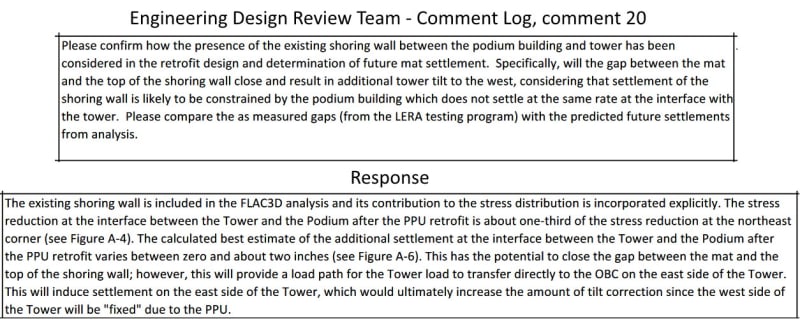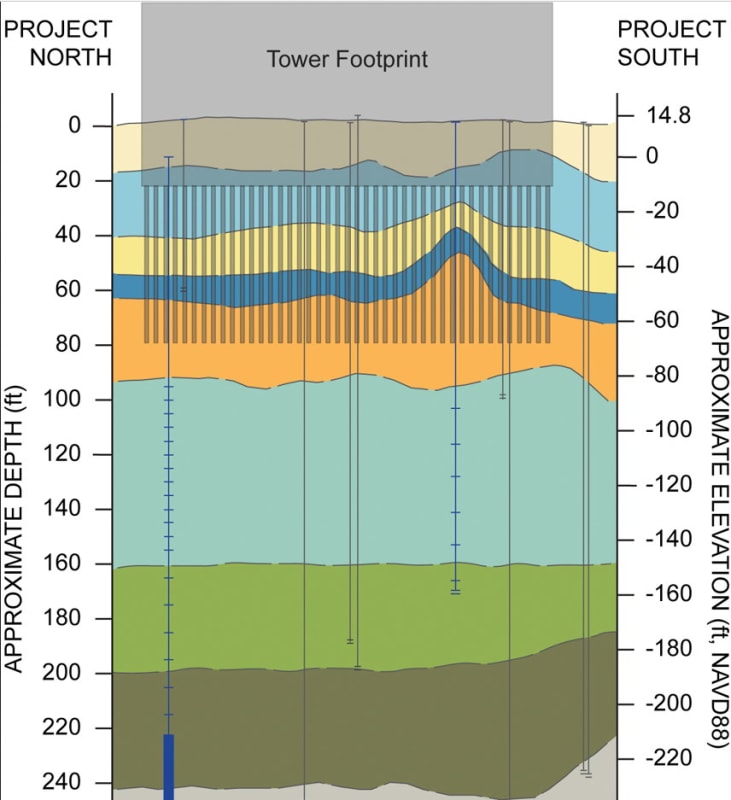hokie66 said:
The other proposal, by Karp-Kardon, also had some unknowns/complications.
Here is a complication regardless of remedial scheme.
It is a very big assumption that the shoring wall would settle along with the tower. Then, there is the entirely new seismic response that goes without discussion.
When the news broke that the retrofit was being paused, the new amount of settlement was given as 2 inches & 5 inches of tilt. Since then, the media has been saying, 1 inch of settlement. SF Supervisor Peskin is still saying 2 inches.
I wonder if the perimeter piling has reached the Colma Sand Hump yet?
Here is a
link to the retrofit monitoring plan by Slate. Courtesy of LB Karp's Millennium Debacle webpage.
One of the members of the expert panel, Shah Vahdani, Ph.D. was on the 80 Natoma Peer Review, chaired by Prof. Jack Moehle. He was asked to write a letter for the 80 Natoma Peer Review panel, stating his opinion of the foundation for 80 Natoma, which was being called into question for the exact same concerns as 301 Mission.
He wrote a half-in/half-out answer. You can read some of his opinion in this SF Building Inspection Commission Meeting, (
Item 6. Paragraph 16). He wrote his response while Myers Construction & Treadwell & Rollo designed the foundation relying on only one boring for the entire site.
While 80 Natoma was under Peer Review, the original 301 Mission St. tower, with 4 basement levels, had already been through Peer Review. SFDBI Plan check in March 2003 was working on MEP plan review when MSD/Millennium put their building on hold. I believe they had received a big NO on moving the utility vault.
MSD/Millennium probably had a stroke when 80 Natoma had their building permit suspended. They rushed out and hired Prof. Jack Moehle, 80 Natoma Chair, right in the midst of the 80 Natoma court battle; in order to "Prescription' their New tower project to the SF 2001 building code. Make no mistake, SFDBI was their to help.
But before MSD/Millennium hired Prof. Jack Moehle, Millennium was stuck. The PG&E vault was going no where. If they stayed with the 4 level basement project, so the PG&E vault could fit into level B2; levels B1 & B2, combined, would have been -25 ft in excavation depth. Along came Webcor with a
solution!
Webcor no longer includes Millennium Tower as a featured project but I have the text of the page, as follows
Webcor: Webcor brought significant value to the project by eliminating the subterranean parking area under the high-rise tower and then sequencing the excavation into two phases. This enabled the high-rise tower erection—the longest item in the schedule—to begin earlier, saving the owner 8 months on the schedule and $6 million in construction costs.
The building’s size and location required a massive foundation system with 10-foot-thick pile caps and a 3-foot-thick core wall. The site also required a highly unique, internal cross bracing system to eliminate off-site movements and support an existing building on the south side. [End]
Fun Fact: Production pile driving started in early March of 2006 for the 301 tower. That year, San Francisco broke its March rainfall record, totaling over 9 inches for the month.
Here is a hydrological study of San Francisco and an excerpt I thought was worthwhile.
“
Geohydrology, Water Quality, and Estimation of Ground-Water Recharge in San Francisco, California 1987-92”
Excerpt:
Modeling from SF Municipal water table recharging results indicate that areal recharge rates for water years 1987-88 for the seven ground-water basins range from 0.32 to 0.78 foot per year.
• Modeling from SF Municipal water table recharging results indicate that areal recharge rates for water years 1987-88 for the seven ground-water basins range from 0.32 to 0.78 foot per year.
• A comparison of the highest horizontal hydraulic conductivity (31 ft/d) with the highest vertical hydraulic conductivity (5.1 ft/d), which can be assumed to occur in the same materials, indicates that the minimum horizontal-to-vertical anisotropy may be about 6:1. The range of horizontal (5 to 31 ft/d) and vertical (0.0018 to 5.1 ft/d) hydraulic conductivities indicates that the coarse-grained deposits that control horizontal flow are relatively continuous, and that fine-grained deposits that control vertical flow are relatively discontinuous. Storage coefficients (table 1) indicate unconfined conditions at depths less than 100 ft (0.01 to 0.32) and confined or semi-confined conditions (0.00024 to 0.0082) at depths greater than 100 ft.
• A linear relation between rainfall and runoff from pervious areas was established such that a threshold rainfall amount had to be surpassed for runoff to occur. The threshold value was assigned based on soil type, ranging from 3 in/mo for clayey soils to 9 in/mo for sandy soils, with a slope of 0.9. [End]
It would have been nice for everyone if a decision had been made to work with only one Elevation reference. It is impossible to keep track of groundwater elevations when they keep switching between bgs, NAVD88 & SF Datum.




![[pipe] [pipe] [pipe]](/data/assets/smilies/pipe.gif)
